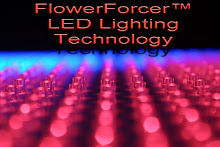The significance of green LED light to growing plants indoors
10:43 PM Edit This
Green LED light is safe to use around plants at night. The significance of green light to indoor growing operations is not entirely understood. Many people believe that green light is unnecessary to the growth of plants. You will have to decide for yourself, but here's a few quotes and links to get you started.
Plant Development vs. Spectrum by Hurley Shepherd, Agricultural Research, USDA Southern Regional Center
Light is very important to plants since that is the source of their energy. Therefore, they must maximize their use of this valuable resource. The chlorophylls are the energy trapping molecules and use light in the blue and red regions of the spectrum (the green is reflected which is why plants usually appear green).
How does a plant get the most out of the red and blue light that is available? Plants have two other pigment systems, one (called "phytochrome")which detects the amount of red light and one (called "cryptochrome")which detects the amount of blue light.
Phytochrome means "plant pigment" and was discovered based on its effects on plant development due to red light. A plant grown in the dark will be tall and spindly, cotyledons not expanded much, and no green color. In the light, it will be shorter, with bigger, green leaves. Red light controls these and other major developmental changes in plants. Some other changes under phytochrome/red light control are germination of seeds and flowering.
Green-light supplementation for enhanced lettuce growth under red- and blue-light-emitting diodes by Kim, H. H., Goins, G. D., Wheeler, R. M., Sager, J. C. of NASA Biological Sciences
The addition of 24% green light (500 to 600 nm) to red and blue LEDs (RGB treatment) enhanced plant (lettuce cv. Waldmann's Green) growth. The RGB plants produced more biomass than the plants grown under the cool-white fluorescent lamps (CWF treatment), a commonly tested light source used as a broad-spectrum control.
Growing Plants with LEDs by Mihaela Lica
Researchers found out that blue and red light is essential for plant growth and, in general, a percentage of 8% blue LEDs and 92% red LEDs, both with the same frequency and relative intensity per LED, are enough for a harmonious evolution. Blue has a smaller influence than red however a percentage between 1% and 20% of blue light can be selected, depending on the plants and their growth requirements. The NASA scientists have tried to create the most cost and energy efficient light sources possible, and this is why they have eliminated from the fixtures other colours normally found in white light. "What we've found basically is that we are able to limit the amount of colour we give to the plants and still have them grow as well as with white light." said the research scientist Greg Goins of Dynamac Corp.
Plant Development vs. Spectrum by Hurley Shepherd, Agricultural Research, USDA Southern Regional Center
Light is very important to plants since that is the source of their energy. Therefore, they must maximize their use of this valuable resource. The chlorophylls are the energy trapping molecules and use light in the blue and red regions of the spectrum (the green is reflected which is why plants usually appear green).
How does a plant get the most out of the red and blue light that is available? Plants have two other pigment systems, one (called "phytochrome")which detects the amount of red light and one (called "cryptochrome")which detects the amount of blue light.
Phytochrome means "plant pigment" and was discovered based on its effects on plant development due to red light. A plant grown in the dark will be tall and spindly, cotyledons not expanded much, and no green color. In the light, it will be shorter, with bigger, green leaves. Red light controls these and other major developmental changes in plants. Some other changes under phytochrome/red light control are germination of seeds and flowering.
Green-light supplementation for enhanced lettuce growth under red- and blue-light-emitting diodes by Kim, H. H., Goins, G. D., Wheeler, R. M., Sager, J. C. of NASA Biological Sciences
The addition of 24% green light (500 to 600 nm) to red and blue LEDs (RGB treatment) enhanced plant (lettuce cv. Waldmann's Green) growth. The RGB plants produced more biomass than the plants grown under the cool-white fluorescent lamps (CWF treatment), a commonly tested light source used as a broad-spectrum control.
Growing Plants with LEDs by Mihaela Lica
Researchers found out that blue and red light is essential for plant growth and, in general, a percentage of 8% blue LEDs and 92% red LEDs, both with the same frequency and relative intensity per LED, are enough for a harmonious evolution. Blue has a smaller influence than red however a percentage between 1% and 20% of blue light can be selected, depending on the plants and their growth requirements. The NASA scientists have tried to create the most cost and energy efficient light sources possible, and this is why they have eliminated from the fixtures other colours normally found in white light. "What we've found basically is that we are able to limit the amount of colour we give to the plants and still have them grow as well as with white light." said the research scientist Greg Goins of Dynamac Corp.





